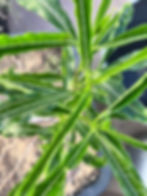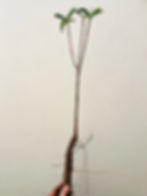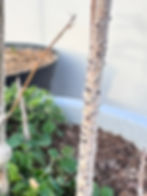

MALAGASY BAOBABS
Known as Bozy in Madagascar, six of the eight species of Baobabs are endemic to the mega island.

Adansonia Grandidieri:
Common Names: Grandidier's Baobab in English or Reniala/Renala in Malagasy.
Known in Malagasy as "The Mother of the Forest", Grandidier's Baobabs boast well deserved worldwide recognition.
These Giant Baobabs can soar to over 100 feet tall or 20 feet wide. They generally grow cylindrically, with statuesque growth patterns.
They're red/copper bark often is found with intricate spiral designs, though no one actually knows what causes them. Their palmate leaves have 5 to 7 leaflets and their dark brown and white flower buds that turn to large, easily broken fruits. The bark is often used for roofing.
The seeds of adansonia grandidieri are much more water permeable than its cousins, bringing their natural germination rates higher than other baobabs.
Classified as endangered primarily due to habitat loss. They can be found growing wild in a small section of coastal West Madagascar.




Adansonia Madagascariensis:
Common Name: Bozy Malandy (Malagasy)
Synonym: Adansonia Bernieri
The first Malagasy Baobab to be officially described on the record, the Madagascar Baobab is also sometimes referred to as Adansonia Bernieri, named after its colonial discoverer.
The trees can grow over 65 feet tall and are often over 15 feet in width. They have smooth, pale grey bark and often have irregular branching patterns.
They have 5 to 7 soft leaflets on their palmate leaves. They boast dark red flowers, the most showy of the baobab flowers, though they can sometimes be yellow as well.
The fruits are usually quite small with a medium-thick velvet-like, woody pericarp/skin.
Similar to Adansonia Za in many ways except their unique fruits. The Madagascar Baobab is classified as "Near Threatened".




Adansonia Perrieri:
Common Name: Bozy (Malagasy)
The most recently described species of baobab, Perrier's baobab has a cylindrical or bottle shaped trunk. They can grow to above 50 feet tall. They have hairy leaves that grow in palmates of 5-11.
They have pale green flowers with a long white stamina tube. They can sometimes also be red or white.
They have large oblong fruits with a thick, brown, hairy coating .
Adansonia Perrieri is very rare and is only found in remote areas of northern Madagascar. It grows in both evergreen and dry deciduous forests.
Growing Perrier's baobabs from seed can take some time, as they have very hard coats.


Adansonia
Za:
Common Name: Za, Zaha, Bozy Be, Ringy (Malagasy)
Synonym: Adansonia Alba
Like its close genetic cousin, Adansonia Madagascariensis, the Za Baobab can grow to about 100 feet and over 10 feet wide.
It has a smooth, steel grey bark. It's leaves are fairly basic among baobabs, with 5-8 smooth leaflets on palmate leaves attached to petiolules that can reach an inch long.
The flowers are green on the outside and dark red within. Its fruits can be small or large, but are often misshapen with a swollen peduncle and thick, rough coats.
Za baobabs are the most abundant of the Malagasy Baobabs, found along the Western part of Madagascar from North to South.
They are classified as Near Threatened, primarily due to habitat loss and a lack of young trees replenishing the forests (climate change).
Adansonia Suarezensis:

Common Names: Bozy Mena, Tsitoloniny (Malagasy)
Suarez Baobabs often grow to about 80 feet tall and 6 feet in diameter. They have a dark red and brown bark with a green photosynthetic layer just beneath it.
Recognized primarily by its unique growth pattern of two massive horizontal branches extending from crown.
Their palmate leaves of 6-9 smooth leaflets are attached to 5 inch petioles. The flowers are white and turn yellow with age. The fruits are huge and plentiful with relatively thin coats. The seeds are huge compared to every other baobab cousins.
Locally, the bark is known to be a medicine for treating ailments like diabetes. The trees are found in very few locations in specific regions of Northern Madagascar.
Suarez Baobabs are classified as endangered mostly due to habitat loss.



Adansonia
Rubrostipa:
Common Name: Fony Baobab
The Fony Baobab is the smallest in the genus. They typically grow no higher than 60 feet and are often stunted based on their environment.
The bark has a reddish to white hue. The palmate leaves cluster in only 3 to 5 and they have serrated, jagged edges.
The flowers are green on the outside and bright red within, with long tubers.
They have smaller round fruits with a thick, brown, hairy coating , which are used to make drinks.
Some trees can yield up to 200kg of fruit per harvest.
Fony baobabs are found along the entire west coast of Madagascar, one of the more resilient varieties.
